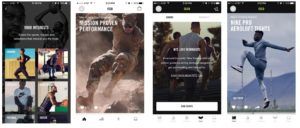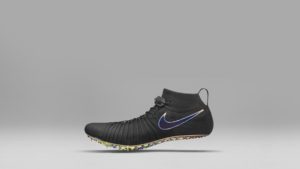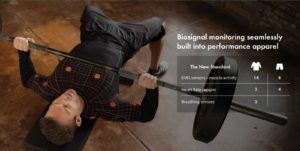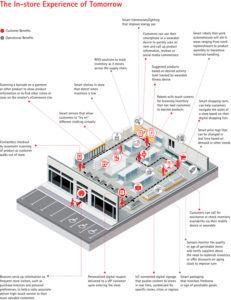Is Nike the Next Big Tech Giant?

Is Nike taking big bets on digital to differentiate itself with customized products and experiences?
Nike has dominated the sports world by aiming to connect with every athlete* through innovation in product and marketing. But to get to Nike’s $50bn sales goal by 20201, it’s using digitization to enhance value by changing how they deliver customized experiences and products to customers.
From Shoeware to Software
In 2006, to expand their shoe ecosystem and become part of their customer’s journey, Nike entered the digital gadget realm by introducing a small sole-insertable chip. Having Tim Cook, then Apple’s COO, on Nike’s board allowed an effortless partnership with Apple by leveraging its hardware as the chip’s receiver to track users’ distances and speed2. In 2012, Nike created the Fuelband that users wore on their wrists and worked in parallel with Apple’s iPhone. Nike developed Apple mobile applications that worked in conjunction with iPhones’ built-in accelerometers and sensors to determine user fitness metrics. Nike recognized that Apple hardware was more sophisticated and the adoption rates of mobile phones were higher than fitness wearables, so 2014 was the end of the Fuelband3. Leaving the hardware to Apple and developing its own software, Nike’s mobile app platform, Nike+, came out as the winner.

Nike+ Expansion
Having built an in-house digital team, Nike has launched a myriad of Nike+ mobile application platforms that collects users’ real-time data while integrating themselves into users’ fitness lives. From running to training apps, Nike + has evolved into a personal assistant that not only tracks workouts but also creates digital and physical communities that connect users and suggests local events. It connects users with tailored fitness regimes and pro-athlete led workouts that in parallel drive awareness to the Nike brand.

All the while, Nike is gathering data for insights into user behavior and interests4. What sets Nike+ apart from competition is their network of in-house pro-athletes, long fitness background and increased strength in software development to design a seamless user interface. This harmonious integration into the lives of the customers makes users forget that what they are logging into is a personalized virtual store.
The Custom Retail Experience
Certain flagship stores now blur the line between physical and digital worlds. Sensor-activated content triggers nearby tablets to educate customers with product reviews, videos and messaging. Large displays take customers into digital product ‘test drives’ while others allow customers to beam associates for help or for instant product purchasing. In-store kiosks digitally present the entire Nike portfolio as well as shoe customization options. Using technology, Nike is immersing customers into their world and automating former human functions to give them personalized, on-demand service that gives each customer a unique experience5.

Revolutionizing Manufacturing
Nike is looking to be a leader in mass customization through their manufacturing revolution initiative. It aims to be as efficient in producing thousands of the same shoe as it is producing thousands of ‘one-of-a-kind’ shoes. It has recently partnered again with the supply chain innovator, Flex, to develop a process to do just that6. Although this partnership first began with Nike’s Fuelband, they are now working together to disrupt the supply chain. They have already began piloting digitized laser beams that seamless cut materials to specified dimensions regardless of order size. Because production no longer needs labor to swap out machining tools between orders, they reduce labor and equipment costs by managing production digitally. This eliminates setup and idle time resulting in shortened delivery time from weeks to days7.
Nike has also introduced 3D printing for two reasons: to improve product and prototype testing and enhance retail experience. In product design, what used to take weeks and months now takes hours for products to be tweaked, made and tested enabling quicker iterative design approaches8. This same technology is also expected to be brought on-site to manufacture custom shoes inside retail stores.

What Next
Smart clothing: Embedding sensors into apparel is a logical step in next-generation clothing9. Not only could clothes monitor body conditions during exercise to give insights on performance but the same technology could detect abnormalities that could prevent serious health problems. Nike could start collecting this data to shift itself into the health industry.

Enhanced retail digital interconnectivity: By leveraging full retail Internet-of-Things (IOT)10, they can move towards full self-managed stores. For example, stores could digitally self-monitor lighting, detect inventory throughput, and communicate with users via their Nike+ apps and beacon technology. Through this increase in data collection, Nike could amass more information on store behavior that could lead to enhanced store utilization, efficiency and sales.

By using digitization to focus on customized experiences and products through retail and supply chain innovation, Nike can better personalize their relationship with their customers. With its brand strength, and increase in digital investment, it can also move forward to be a leader and pioneer in not only fitness but also next-generation health-care.
*anyone with a body
Word Count: 800
1 Trefis Team, “Here’s How Nike Is Innovating To Scale Up Its Manufacturing”, Forbes, May 18, 2016, http://www.forbes.com/sites/greatspeculations/2016/05/18/heres-how-nike-is-innovating-to-scale-up-its-manufacturing/#13036b277024, accessed Nov 2016.
2 Nike and apple team up to launch Nike+iPodGlobal; collaboration brings the worlds of sports and music together like never before. (2006, May 23). PR NewswireRetrieved from http://search.proquest.com.ezp-prod1.hul.harvard.edu/docview/447661731?accountid=11311
3 Lucy Ingham, “Nike FuelBand’s Demise: End of Wearable Tech or a Sign of Bigger Things?”, factor-tech.com, April 22, 2014, http://factor-tech.com/wearable-technology/2731-nike-fuelbands-demise-end-of-wearable-tech-or-a-sign-of-bigger-things/, accessed Nov 2016.
4 Darren Heitner, Just Do Digital: Nike’s Fundamental Shift To Direct-To-Consumer”, Forbes, Aug 2, 2016.http://www.forbes.com/sites/darrenheitner/2016/08/02/just-do-digital-nikes-fundamental-shift-to-direct-to-consumer/#44cc800b707a, accessed Nov 2016.
5 Nike soho debuts the future of sport retail. (2016, Nov 09). Business Wire Retrieved from http://search.proquest.com.ezp-prod1.hul.harvard.edu/docview/1837411849?accountid=11311
6 Flextronics, “Company News”, http://investors.flextronics.com/investor-relations/company-news/press-release-details/2015/NIKEs-Manufacturing-Revolution-Accelerated-by-New-Partnership-with-Flex/default.aspx, accessed Nov 2016.
7 “Recoding the Run”, intelligenceofthings.com, https://www.theintelligenceofthings.com/article/recoding-the-run/, accessed Nov 2016.
8 Nickolaus Hines, “Here’s How Nike Will Probably 3D Print Your Next Shoes”, May 17, 2016, https://www.inverse.com/article/15779-here-s-how-nike-will-probably-3d-print-your-next-shoes, accessed Nov 2016.
9 Sean Everett, “The Importance of Nike to Apple’s Future Smart Clothing Product”, June 6, 2016, https://humanizing.tech/the-importance-of-nike-to-apples-future-smart-clothing-product-b9c0f3370173#.9z45ps1x9, accessed Nov 2016.
10 Accenture, “Accenture Strategy”, https://www.accenture.com/us-en/insight-internet-things-revolutionizing-retail-industry, accessed Nov 2016



Thank you for the wonderful insight into this amazing organization, Eric! As a huge Nike fan, I absolutely agree that they are not just transforming themselves into a tech giant, but also a social media provider. The way that Nike structures its business is testament to this – their matrix model divides the organization into activities (e.g., Running, Golf, Football) first, and geography second. The theory behind this is that people who are interested in that activity have more things in common than people who live closer together[1]. This has allowed Nike to build a compelling social media presence through its Nike+ community and apps. What I’ve found interesting through the last few iterations of the Nike Running app is that it has transformed from being a running tracker where you can share information on Facebook / Instagram, to a social media platform of its own account – in the latest versions, you can take photos and track your runs, just to share globally with the Nike+ running community, not merely as a link to other, more established, social media platforms.
I am curious to see how Nike deals with the opportunities and threats arising from wearable technology. Given the lukewarm customer reviews of the Apple Watch (and Nike’s collaboration), I am not sure that exiting the FuelBand market was the right long-term move. Further, I see Under Armour as a huge threat to Nike in the smart clothing space as UA doubles down on wearable fitness [2]. I wonder what Nike’s move in that space will be.
[1] http://fortune.com/2015/11/12/nike-ceo-mark-parker/
[2] https://www.wired.com/2016/01/under-armour-healthbox/
Eric, even since we discussed Nike in MKT earlier in the term, I was hoping someone would bring it up in a TOM context! I think it is a fascinating case study of a company that is truly at the forefront of the retail industry in terms of design, innovation, customer experience, marketing, and now, technology. Their new digital products and enhanced retail/e-commerce experience doesn’t surprise me given Nike’s target customer: the athlete. Athletes are all about performance and improvement, so they naturally would expect the products in their life to keep up with them and help them achieve their goals. The pressure is on for Nike to retain these customers and maintain their status as a revolutionary retailer so I was particularly interested in your suggestions around smart clothing. I recently saw an article about Nike’s self-lacing shoes which demonstrates how they plan to move beyond devices and further integrate technology into their apparel and shoes. I am curious to see how Nike continues down the path of smart clothing and how users react to this new strategy.
[1] https://techcrunch.com/2016/11/15/hyperadapt/
Interesting post, Eric! I’m generally skeptical about the long-term viability of wearables for fitness monitoring, which in many ways seems like a fad. But I agree that there is a role for smart clothing and footwear to provide value in the healthcare industry, especially as insurance providers and healthcare systems look to transition to value-based care. The need to improve preventative care is core to a value-based care system, and wearables are a natural way in which to improve that part of the healthcare spectrum.
As a large multinational company, what will be important for Nike is to consider whether to build/buy/partner to have a seat at the healthcare continuum of care table (if they decide they even want one at all), because companies like Sensoria [1] are quickly recognizing that this is an important part of the wearables market and might be able to move more nimbly than Nike, especially if they have the outside capital to fund their product development/commercialization.
[1] http://www.sensoriafitness.com/healthcare
Thanks for the post! The efforts Nike has done in bringing the digital world into the athletes’ world certainly deserved a blog post here. Nike has created a complete virtual environment that tries to mirror the marketing efforts done at the store, on TV, and with the sponsorships. Integrating the technology into the shoes and apparel itself is the new frontier for sport goods companies, and Nike has the app experience to serve as the initial point for that strategy.
However, I’m not entirely sure if the market is big enough at the moment for a radical transformation in the industry and a massive migration to smart clothing. The experience of the Apple Watch shows that not everyone is willing to use a new technology just because it’s new. Same can happen with clothing, only the real die-hard athletes will see the value of paying more to get intelligent shoes. The average user might be willing to change some of that technology for lower prices. It’s a challenge for the company to keep pushing the boundaries of the industry without leaving a large number of customers behind.
Completely agree on the potential for data collection and actually want to take it one step further. The post linked below talks about the amount of data Procter and Gamble has access to simply because of the scope of their business. I would assume the same is the case for Nike. As they roll out new products like the smart clothing (which I think is a great idea), I think they have a huge competitive in the space due to the data they’ve collected both with with Nike+ and the consumer data they’ve been amassing for decades. I see this data assisting them in everything from recommending specific “Smart-wears” to individuals based on purchasing patterns and fitness levels, to identifying consumer trends in predicting which smart clothing lines to invest in.
https://d3.harvard.edu/platform-rctom/submission/pg-bringing-cpg-into-the-digital-age/
Thanks for the post, as a big lover of the NIKE brand, I’m glad to see they’re embracing Digitalization.
Had a few reactions to your post:
– Do you think the wearables technology will get greater traction? – I feel like there are still many consumers who still don’t care much about wearable for fitness technology
– Enhancing the clothes with this fitness technology introduces additional cost. How do you think NIKE will price these enhanced items? and how do you think consumers will react? NIKE is already a very expensive brand as it is, so I expect this will further drive up the cost of their goods
Great read Eric! Nike is definitely at the forefront of digital transformation, especially amongst their category. The best part being their focus on using digital technology to make a personal connect with the customer. As summarized by Nike’s CEO Matt Parker – “Digital, of course, also allows us to deepen the relationships we already have with consumers by tailoring every interaction to their specific needs” [1]
To further this connect, Nike recently launched the special edition Nike+ Apple watch. Enabled with the Nike+ Running app, it is the latest wearable to help connect to the 30 million strong Nike+ community [2]. Giving the functionalities through a single application, to be able manage their lifestyle, track their progress and connect with their peers on social media should definitely be a winner with the millennials.
Of course, no post on Nike and their technological innovations and smart clothing can be complete without mentioning the awesome new self-tying Hyper Adapt 1.0 [2], based on the legendary shoes from “Back to the Future”. Can’t wait to order mine!
[1] http://www.cnbc.com/2016/03/17/first-on-cnbc-cnbc-transcript-nike-ceo-mark-parker-speaks-with-cnbcs-sara-eisen-on-squawk-on-the-street-today.html
[2] http://www.nikefuellab.com/
[3] http://news.nike.com/news/hyperadapt-adaptive-lacing